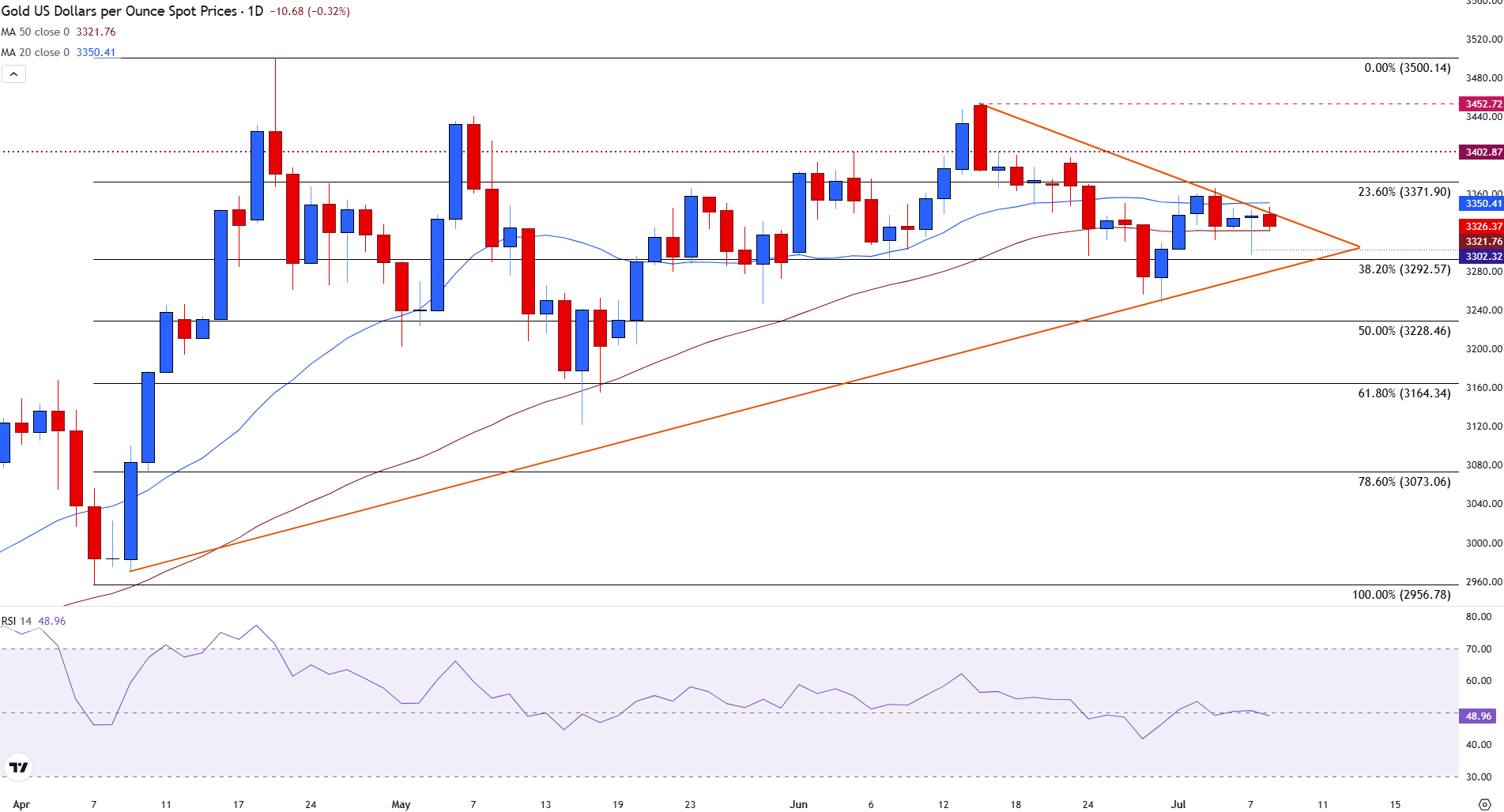- Gold price plunges as risk-sentiment eases after Trump announces an extension of the tariff deadline.
- Expectations of Fed interest rates continue to weigh on bullion ahead of the FOMC Meeting Minutes scheduled for release on Wednesday.
- XAU/USD slips below $3,300, opening the door for a test of triangle support near $3,280.
Gold (XAU/USD) is weakening on Tuesday, as markets cheer news that reciprocal tariffs will take effect on August 1, rather than July 9.
US President Donald Trump’s consistent tariff threats have temporarily muted demand for the yellow metal while supporting the demand for the Greenback. The president has announced new tariffs on countries, with Japan at 25% and South Korea at 30% standing out.
The yellow metal is down 1.20% intraday, and the lack of conviction reflects ongoing indecision amid conflicting macro forces and stable US Treasury yields.
The recent price action has been defined by a series of lower highs and higher lows, compressing into a classic triangle structure on the daily chart. This pattern typically precedes a sharp directional move, but the breakout trigger remains elusive.
While safe-haven demand offers some underlying support, stronger-than-expected US labor market data and hawkish Federal Reserve (Fed) expectations have capped any upside extension for Gold.
Gold daily digest market movers: XAU/USD remains alert ahead of FOMC Minutes
- The Federal Open Market Committee will release the Minutes from its last meeting on Wednesday. This report outlines the reasons for maintaining interest rates at the current range of 4.25% to 4.50% in June.
- German Industrial Production data, released on Monday, showed a 1.2% monthly increase in May. Upbeat economic data has helped drive recession fears lower, adding pressure on the yellow metal.
- The BRICS summit in Rio de Janeiro ended on Monday. The emerging market nations that established the bloc are beginning to reduce their reliance on the United States. This initiative includes moving away from using the US Dollar as a receiving currency, a concept known as de-dollarization.
- Trump wrote a post on Truth Social also on Monday stating that “Any country aligning themselves with the Anti‑American policies of BRICS, will be charged an ADDITIONAL 10 % tariff. There will be no exceptions to this policy.”
Gold trades sideways near $3,300 as triangle breakout looms
From a technical standpoint, Gold has fallen below the 50-day Simple Moving Average (SMA) at $3,321, with the 20-day SMA acting as additional resistance at $3,350.
The current structure suggests a slightly bearish bias, with a sustained break below the 23.6% Fibonacci retracement of the April rally at $3,292 increasing downside risk.
Gold (XAU/USD) daily chart

On the upside, the precious metal could stage a strong upward move if it breaks above the upper boundary of the symmetrical triangle, particularly with a decisive close above the 20-day SMA at $3,350.
Additionally, any resurgence in geopolitical tensions or global trade disputes could trigger renewed safe-haven demand, further fueling a rally. If bullish momentum takes hold, XAU/USD may target the $3,375–$3,400 area, with the potential to retest all-time highs if broader risk sentiment deteriorates.
US Dollar FAQs
The US Dollar (USD) is the official currency of the United States of America, and the ‘de facto’ currency of a significant number of other countries where it is found in circulation alongside local notes. It is the most heavily traded currency in the world, accounting for over 88% of all global foreign exchange turnover, or an average of $6.6 trillion in transactions per day, according to data from 2022.
Following the second world war, the USD took over from the British Pound as the world’s reserve currency. For most of its history, the US Dollar was backed by Gold, until the Bretton Woods Agreement in 1971 when the Gold Standard went away.
The most important single factor impacting on the value of the US Dollar is monetary policy, which is shaped by the Federal Reserve (Fed). The Fed has two mandates: to achieve price stability (control inflation) and foster full employment. Its primary tool to achieve these two goals is by adjusting interest rates.
When prices are rising too quickly and inflation is above the Fed’s 2% target, the Fed will raise rates, which helps the USD value. When inflation falls below 2% or the Unemployment Rate is too high, the Fed may lower interest rates, which weighs on the Greenback.
In extreme situations, the Federal Reserve can also print more Dollars and enact quantitative easing (QE). QE is the process by which the Fed substantially increases the flow of credit in a stuck financial system.
It is a non-standard policy measure used when credit has dried up because banks will not lend to each other (out of the fear of counterparty default). It is a last resort when simply lowering interest rates is unlikely to achieve the necessary result. It was the Fed’s weapon of choice to combat the credit crunch that occurred during the Great Financial Crisis in 2008. It involves the Fed printing more Dollars and using them to buy US government bonds predominantly from financial institutions. QE usually leads to a weaker US Dollar.
Quantitative tightening (QT) is the reverse process whereby the Federal Reserve stops buying bonds from financial institutions and does not reinvest the principal from the bonds it holds maturing in new purchases. It is usually positive for the US Dollar.





